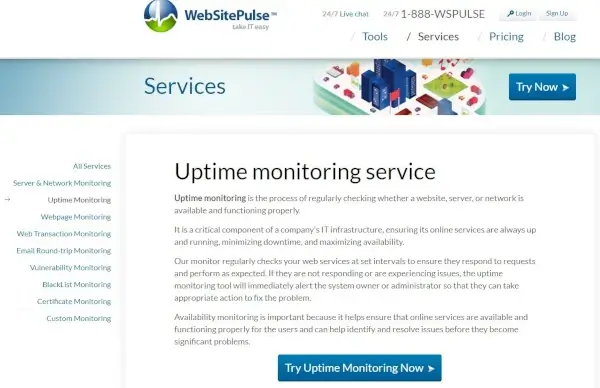
Website downtime refers to the period when a website is inaccessible or experiences disruptions, resulting in users being unable to access its content or services.
In today's digital landscape, websites are crucial to business success and user engagement. The reliability of a website is paramount as it directly affects user experience and brand perception.
User trust is the foundation of any successful online interaction. It influences user behavior, loyalty, and the likelihood of returning to a website. On the other hand, brand perception is how users perceive a brand, shaped by various experiences and interactions.
This article explores the psychological effects of website downtime on user trust and brand perception.
The Role of Website Reliability in User Trust
Website Reliability and User Trust
Website reliability, encompassing uptime and performance, is a cornerstone in cultivating and preserving user trust. When a website is consistently accessible and functions without glitches, users develop a sense of reliability and dependability toward the brand or organization. On the contrary, frequent website downtime or slow loading times can breed doubt and skepticism in users, eroding their trust in the website and the brand it represents.
Importance of Trust in Online Interactions
Trust is a vital currency in the virtual landscape that underpins user interactions. Online users entrust their personal information, financial data, and time to websites they believe to be trustworthy. A website that inspires confidence and provides a secure, seamless experience fosters positive user perceptions and establishes a strong foundation for long-lasting relationships.
Factors Affecting User Trust in Websites
User trust is an amalgamation of multiple factors. Besides website performance, security measures, such as SSL/TLS encryption and data protection, contribute to user confidence. Transparent communication, especially during downtime or technical issues, showcases accountability and can help rebuild trust. Additionally, past experiences with the brand, including customer service and product quality, play a significant role in shaping user trust in the website.
The Impact of Website Downtime on User Experience
Impact on User Behavior and Experience
Website downtime has significant repercussions on user behavior and experience. When a website becomes inaccessible due to downtime, it disrupts the user journey, resulting in frustration and negative emotions.
Users rely on seamless access to information and services, and any interruption can lead to a sense of inconvenience, prompting them to seek alternative solutions or abandon the website altogether. Interrupting a user's flow can deter them from completing essential tasks like purchasing or accessing critical information, impacting user satisfaction and loyalty.
Psychological Responses to Downtime
Encountering website downtime can evoke various psychological responses in users. The experience of being unable to access a website or encountering errors may lead to feelings of anxiety, annoyance, or even anger.
Users might feel a loss of control or a sense of helplessness when confronted with a non-functional website, especially during crucial moments. The psychological impact of downtime can linger even after the website is restored, as users may remain wary of potential future disruptions, affecting their trust in the website's reliability.
User Frustration and Dissatisfaction
Downtime directly contributes to user frustration and dissatisfaction with a website. The inability to access desired content or complete tasks can lead to a decline in overall user satisfaction. Moreover, prolonged or recurring downtime incidents can tarnish the website's reputation, affecting the users' perception of the brand it represents.
Dissatisfied users may share negative experiences with others, further impacting the brand's image and potentially deterring new users from engaging with the website. Maintaining website reliability is crucial in fostering positive user experiences and reinforcing trust in the brand.
User Return Rate Post-Downtime
When users experience website downtime, their likelihood of returning to the site diminishes significantly. The frustration and inconvenience caused by downtime can leave a lasting negative impression, decreasing user loyalty.
Consequently, the website may lose recurring traffic and potential customers, which will impact overall user engagement and conversion rates.
User Perception of Brands and Downtime

Website Downtime and Brand Perception
The impact of website downtime extends beyond the technical realm and directly influences how users perceive a brand. On desktop, the typical web page load time is approximately 2.5 seconds, while on mobile, it extends to around 8.6 seconds. A website that experiences frequent downtime or slow loading times can convey a lack of reliability and professionalism, damaging the brand's reputation.
On the other hand, a consistently reliable website reinforces positive brand associations, building trust and credibility with users. The website serves as a virtual storefront, and any disruption can lead to user frustration and a diminished perception of the brand's commitment to delivering a seamless experience.
Consistency in Brand Building
Consistency is key to establishing a strong and cohesive identity in brand building. This consistency extends to website performance and reliability.
A website that consistently delivers a smooth and reliable user experience reinforces the brand's promise and values. Users come to associate positive experiences with the brand, leading to increased trust and loyalty over time.
Conversely, inconsistency in website performance can create cognitive dissonance, where users struggle to reconcile their positive perceptions of the brand with the negative experience of downtime.
Psychological Impact of Downtime on Brand Reputation
The psychological consequences of brand damage caused by downtime can be substantial.
When users encounter website downtime, they may feel a sense of disappointment, frustration, or even betrayal. This negative emotional response can result in users sharing their negative experiences with others, both online and offline, leading to negative word-of-mouth.
As brand perception shifts, the brand's reputation takes a hit, impacting customer acquisition and retention.
The Cognitive Dissonance of Website Downtime

Cognitive Dissonance and Downtime
Cognitive dissonance occurs when users face a conflict between their belief in a brand's (or technology's) reliability and the actual experience of encountering website downtime. Users who previously had positive perceptions of the brand may struggle to reconcile this positive image with the frustration and inconvenience caused by downtime incidents.
Reconciling Beliefs with Downtime
To reduce cognitive dissonance, users may rationalize the downtime, giving the brand the benefit of the doubt. However, if downtime incidents persist, these efforts to reconcile beliefs with reality can be challenged, potentially leading to a shift in brand perception and trust.
Mitigating Dissonance and Restoring Trust
To mitigate cognitive dissonance and restore user trust, brands should adopt open communication during downtime incidents. Taking responsibility for the issue and providing regular updates on the website's status can help users understand the situation better.
Moreover, investing in robust website infrastructure and implementing a comprehensive downtime response plan can instill user confidence and reinforce the brand's trustworthiness.
For professionals seeking to delve into the psychology behind brand perception and user behavior, exploring the best psychology master's programs online could be a valuable opportunity to gain expertise in this field.
Rebuilding User Trust Post-Downtime

Downtime Communication Strategies
Maintaining user trust during downtime incidents requires transparent and timely communication. Keeping users informed about the downtime's cause and expected resolution helps manage their expectations and minimizes frustration.
Brands should utilize various communication channels, such as website banners, social media, and email notifications, to promptly reach out to affected users.
Transparent Downtime Information
Providing detailed information about the root cause of downtime demonstrates accountability and transparency. Users appreciate knowing that the brand acknowledges and is actively working to resolve the issue.
Transparent communication fosters a sense of trust and shows that the brand takes downtime incidents seriously.
Preventing Future Downtime
To instill user confidence, brands must implement proactive measures to prevent future downtime.
Uptime monitoring services regularly check your web services at specified intervals to verify their responsiveness and performance. Should any issues arise where the services are unresponsive or not performing as expected, the monitoring tool will promptly notify the system owner or administrator. This immediate alert enables them to take necessary actions to address and resolve the problem promptly.
Restoring Trust with Feedback
User feedback and testimonials are crucial in restoring trust after downtime incidents. Brands can leverage positive customer experiences shared through testimonials and reviews to showcase their commitment to customer satisfaction.
Engaging with users' feedback and addressing their concerns demonstrates a dedication to continuous improvement, further strengthening brand trustworthiness and loyalty.
Best Practices for Mitigating Downtime Effects on User Trust and Brand Perception
The cost of downtime varies significantly between larger and smaller companies. For relatively small businesses, downtime expenses typically range from a few hundred per minute, while larger enterprises face much higher costs, reaching several thousand to over a million per hour. In March 2019, Facebook lost nearly $90 million due to a 14-hour downtime.
Investing in robust website infrastructure and hosting solutions
Website reliability hinges on a solid foundation, necessitating adequate investment in robust infrastructure and reliable hosting solutions. Ensuring the website can handle traffic spikes and scale as needed is critical to avoid performance bottlenecks and downtime incidents. Additionally, partnering with reputable hosting providers with high uptime guarantees enhances website stability and reduces the risk of unexpected disruptions.

Utilizing website monitoring tools to detect and address downtime quickly
Website monitoring tools are invaluable in promptly identifying and addressing downtime incidents. Uptime monitoring services regularly check your web services at specified intervals to verify their responsiveness and performance.
Should any issues arise where the services are unresponsive or not performing as expected, the monitoring tool will promptly notify the system owner or administrator. This immediate alert enables them to take necessary actions to address and resolve the problem promptly.
Preparing and implementing a comprehensive downtime response plan
A well-defined downtime response plan is essential to handle incidents efficiently. The plan should outline roles, responsibilities, communication protocols, and escalation procedures. During downtime, a clear and effective communication strategy ensures that users are informed about the issue and expected resolution time, mitigating potential frustration and confusion.
Conducting regular user feedback and satisfaction surveys
Gathering user feedback and conducting satisfaction surveys are crucial for understanding user sentiments and identifying potential issues. These insights enable brands to make data-driven improvements to website performance and user experience, reducing the risk of downtime due to user-related issues. Regular feedback assessment reinforces the brand's commitment to user-centricity and helps build trust among the user base.
Navigating the Downtime Dilemma: Building Trust in the Digital Era
In the ever-evolving digital era, understanding the impact of website downtime on user trust and brand perception is paramount. Downtime's emotional and cognitive effects can profoundly influence user behavior and loyalty. Therefore, prioritizing website reliability becomes a cornerstone of establishing brand trust.
Proactive communication during downtime incidents is crucial in mitigating negative perceptions and retaining user trust. By taking prompt and transparent action, brands can effectively restore confidence in their services.
Adopting robust strategies to ensure website reliability becomes essential as businesses navigate the downtime dilemma. To safeguard user trust and brand reputation, brands can turn to WebSitePulse's online monitoring service—an invaluable tool that provides continuous surveillance, enabling swift response to downtime incidents and enhancing overall website performance.


 Copyright 2000-2025, WebSitePulse. All rights reserved.
Copyright 2000-2025, WebSitePulse. All rights reserved.